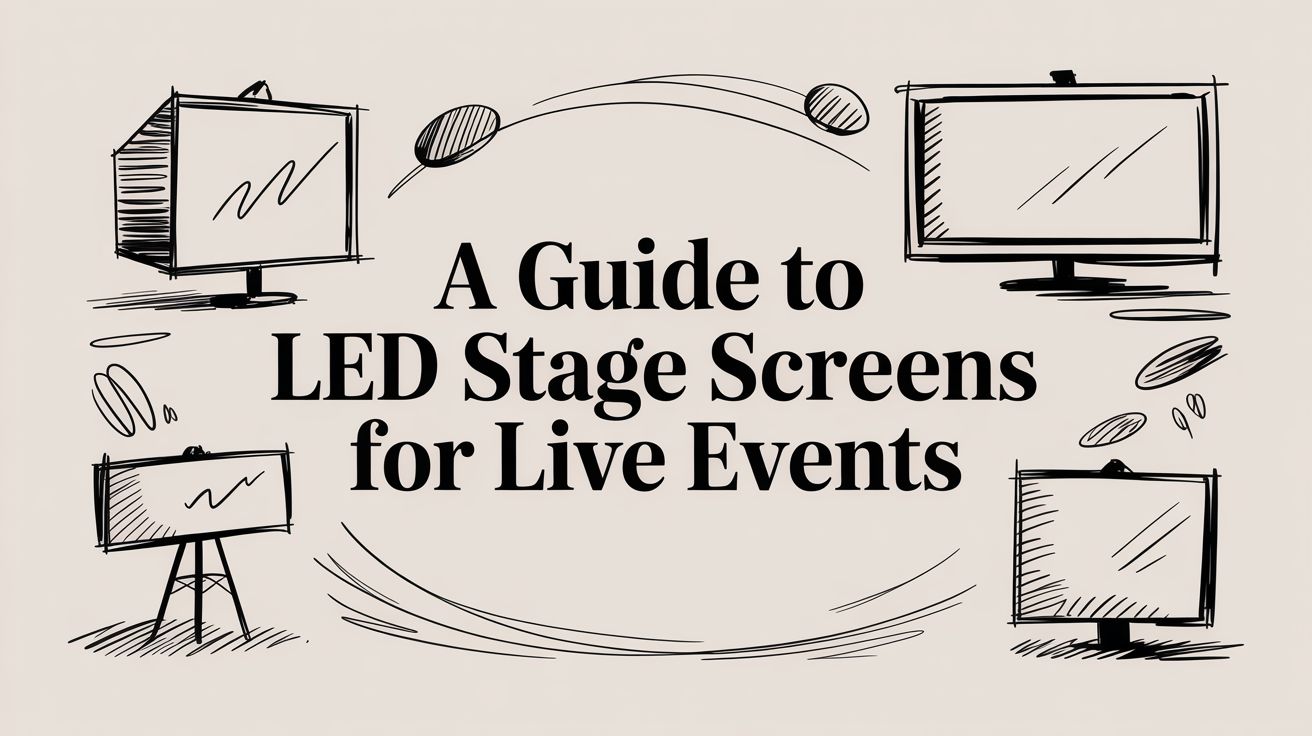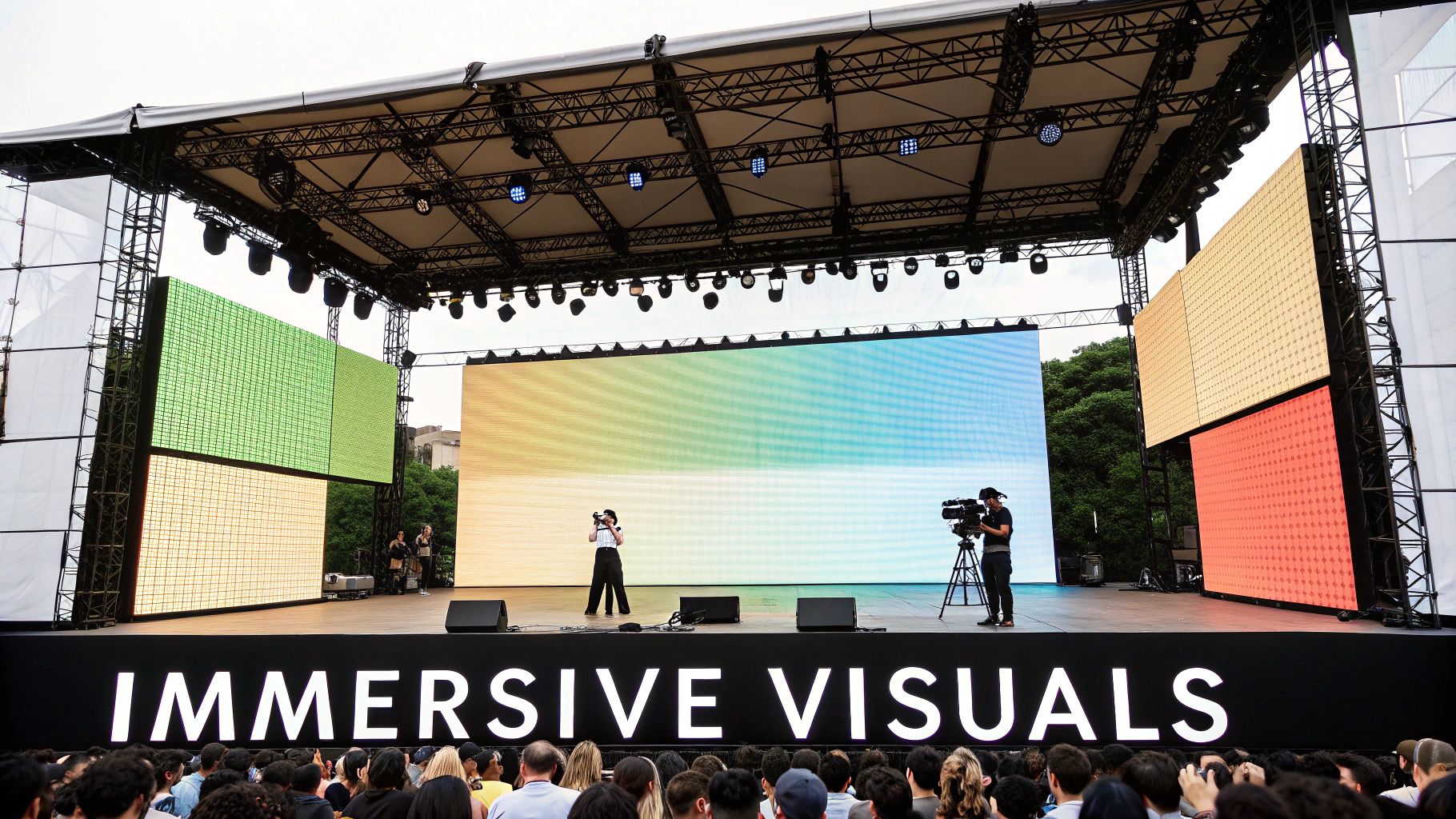
Choosing Scoreboards for Basketball A Complete Guide
A modern basketball scoreboard is so much more than a device for tracking numbers; it's the central nervous system of the entire game-day experience. It’s

At its core, an LED stage screen is a big, bright, modular video display that serves as a dynamic digital backdrop for just about any live event you can imagine—concerts, conferences, you name it. They’re the secret sauce for creating those "wow" moments and making sure everyone in the room, from the front row to the back, has a great view of what's happening.

Walk into any modern concert or corporate summit today, and you can’t miss the visuals. That’s the magic of LED stage screens. They aren't just displays; they're dynamic digital canvases that completely reshape the audience's experience. Think of them as a visual bridge, connecting performers and speakers with every single person in the venue, no matter how far back they’re sitting.
These modular video walls have become an absolute staple for crafting engaging atmospheres, whether it’s for a massive festival main stage or an intimate keynote presentation. Because they can show high-resolution video, live camera feeds (often called IMAG, or image magnification), and stunning graphic animations, event producers can design a complete sensory journey from start to finish.
The real power of an LED screen is its versatility. It can flip from a branded welcome message to a live performance feed and then to an abstract art piece in a matter of seconds. This means a single stage can evoke multiple moods and deliver different messages without anyone having to physically change the set.
For event organizers, this is a game-changer. It means:
It’s no surprise that this technology is everywhere now. The global LED display market is expected to hit around USD 9.39 billion in 2025 and is projected to climb to about USD 15.15 billion by 2035. That kind of growth shows just how essential these displays have become across both entertainment and advertising. You can dig deeper into the LED display market trends at Business Research Insights.
This guide is here to break down what makes LED stage screens so valuable. We'll walk you through everything, from the basic concepts to the smart, practical decisions you'll need to make for your own events.

Choosing the right LED stage screens isn’t about picking the biggest or brightest option off the shelf. It’s about learning the language. A spec sheet can feel like a wall of technical jargon, but cracking that code is the key to matching a display to your vision.
Think of it like buying a pro camera. You wouldn’t just look at the size; you’d obsess over the lens quality, sensor, and low-light performance. It’s the same with LED screens. The best choice is always the one with the right combination of specs for your venue, your audience, and your content.
Let’s break down the metrics that truly matter.
The first and most important spec you’ll encounter is pixel pitch. This is simply the distance, measured in millimeters (mm), from the center of one tiny pixel to the center of the next. It’s the single biggest factor that dictates how sharp your image looks from a certain distance.
It's a lot like the grain in a photograph. A low pixel pitch (like 2.6mm) means the pixels are packed tightly together, creating a dense, razor-sharp image that looks incredible up close. This is perfect for corporate stages, trade show booths, or any setting where your audience is just a few feet away.
On the other hand, a higher pixel pitch (think 6mm or 10mm) means the pixels are spaced further apart. It’s a bit counterintuitive, but from far away, our eyes blend these individual dots of light into a smooth, cohesive picture. This is the go-to for massive outdoor concerts and festivals where the crowd is hundreds of feet back.
Key Takeaway: The relationship is simple—the closer your audience, the smaller the pixel pitch you need. A good rule of thumb is that the minimum viewing distance in meters is roughly the same as the pixel pitch in millimeters. For a 4mm pitch screen, your audience needs to be at least 4 meters (about 13 feet) back for the image to look seamless.
How do you make sure your screen pops under intense stage lights or, even tougher, direct sunlight? The answer is brightness, measured in a unit called nits. One nit is a standard measure of light intensity, and it’s your best weapon against ambient light.
For indoor events like conferences or church services, a screen rated between 800 to 1,500 nits is usually more than enough. In a controlled environment, anything more can actually be overpowering and cause eye strain.
Outdoor LED stage screens are playing a completely different game. They have to compete with the sun, the ultimate light source. For these applications, you need a screen rated at 5,000 nits or higher to ensure your content stays vibrant and legible, even on a cloudless afternoon.
Pixel pitch and brightness are about what the audience sees in person. Refresh rate is all about what the camera sees. Measured in Hertz (Hz), this spec tells you how many times per second the screen redraws the entire image.
Ever seen a video of a screen with ugly black bars scrolling through it? That’s a low refresh rate at work. A standard 60Hz display might look fine to the naked eye, but it will cause flickering and banding on a camera feed.
For any professional production that involves filming or live streaming, you need a refresh rate of at least 1,920Hz. For true broadcast-quality video, 3,840Hz or higher is the gold standard, guaranteeing a perfectly smooth, flicker-free picture for viewers at home.
Finally, there’s color depth, which determines just how many colors the screen can produce. Measured in bits, it defines the richness of your visuals and the smoothness of color gradients.
This table puts it all together, showing how these specs line up for different types of events.
| Specification | What It Means | Ideal for Close Viewing (e.g., Corporate Stage) | Ideal for Far Viewing (e.g., Festival Main Stage) |
|---|---|---|---|
| Pixel Pitch | Distance between pixels; determines sharpness. | Low (1.9mm – 3.9mm) | High (4.8mm – 10mm) |
| Brightness (Nits) | Light output; essential for visibility. | Moderate (800 – 1,500 nits) | Very High (5,000+ nits) |
| Refresh Rate | How often the image is redrawn; crucial for cameras. | High (≥1,920Hz) | Ultra-High (≥3,840Hz) |
| Color Depth | The number of displayable colors. | 10-bit or higher for smooth gradients. | 10-bit or higher for vibrant visuals. |
Once you get a handle on these core concepts, you can confidently look at a spec sheet and know exactly what you’re getting. You'll be able to choose a screen that delivers a flawless visual experience for every person in the room—and everyone watching on camera.

This is where the rubber meets the road—turning a brilliant idea for a massive video wall into a functional, breathtaking reality. Planning your LED stage screen deployment isn't just about picking out the tech; it's about making that technology work seamlessly within a physical space. Success is all about a smart, systematic approach that considers everything from audience sightlines to the structural steel holding it all up.
It all starts with the most fundamental question: how big should the screen actually be? The answer isn’t as simple as “go big or go home.” It’s a delicate balance between the venue’s scale, the resolution of your content, and where your audience is sitting. An oversized screen can feel claustrophobic and overwhelming in a small room, while a screen that’s too small in a massive arena will get completely lost.
A tried-and-true industry guideline is the "4-6-8 Rule," a simple way to estimate the screen's height based on its purpose:
Once you’ve nailed down the ideal height, the width is easy. Just calculate it based on your content's aspect ratio, which is almost always 16:9 for standard HD video. This simple math ensures every single person in the room has a great view.
With the perfect size in mind, your focus has to shift to the nitty-gritty of installation. This is where a detailed logistical check separates the pros from the amateurs. You have to be absolutely sure the stage or venue can handle your vision.
First up: weight. LED panels, especially when you start building a massive wall, are heavy. A single 500mm x 500mm panel can weigh between 15 to 20 pounds, and a large screen can easily add up to thousands of pounds. Always, always check the venue's tech specs or bring in a structural engineer to confirm the stage can bear the load.
Next, you need to figure out how you'll rig it. If you're "flying" the screen (suspending it from the ceiling), you must use certified rigging points with a known safe working load. If you plan to ground-stack it from the stage floor, you need a surface that's perfectly level and stable. Putting together a guide to a flawless stage setup always highlights these points, because one mistake here can be disastrous.
Crucial Tip: Power is the one thing everyone forgets until it’s too late. LED screens are power-hungry. You need to calculate the total draw (max consumption per panel times the number of panels) and get a certified electrician to make sure you have enough clean, stable power on site.
The final piece of the planning puzzle is the environment itself, particularly for outdoor shows. You can't control the weather, but you can make sure your gear is ready for it. This is where IP (Ingress Protection) ratings become your best friend.
An IP rating has two digits:
For any outdoor LED stage screen, IP65 is the gold standard. This means the screen is totally sealed against dust and can handle low-pressure water jets from any direction. In short, it’s rain-proof. For indoor gigs, you don't need that level of protection, which opens up a wider world of panel options. If you know you'll be indoors, you can check out the specs on dedicated indoor LED wall panels to find the perfect fit.
By walking through these stages—sizing, logistics, and environment—you build a rock-solid foundation for an event that looks absolutely incredible.
The world of LED stage screens doesn't stand still. New breakthroughs are constantly redefining what's possible in visual storytelling, unlocking creative potential that felt like pure science fiction just a few years ago. These aren't just minor tweaks; they're huge leaps forward in how designers can build immersive, three-dimensional worlds.
This whole evolution boils down to shrinking the core components—the LEDs themselves. By making them smaller and more precise, manufacturers are delivering incredible gains in picture quality. We're talking about visuals that feel more real and lifelike than ever before. It’s a journey from great to absolutely breathtaking, and it all starts at the microscopic level.
The biggest buzz right now is around Mini-LED and Micro-LED technologies. Think of a standard LED as a tiny lightbulb. Well, Mini-LED shrinks that lightbulb way, way down, letting manufacturers pack thousands of them into a single display.
This incredible density allows for far more precise control over backlighting, creating hundreds or even thousands of "local dimming zones." The result? A massive boost in contrast. You get deep, inky blacks sitting right next to intensely bright highlights. It’s a total game-changer for content with a huge range of light and shadow.
Micro-LED takes things even further. It gets rid of the backlight completely by using microscopic, self-emissive LEDs for every single pixel—similar to how OLED works. This means you get perfect blacks and a near-infinite contrast ratio, but with the awesome brightness and long lifespan that LEDs are famous for.
Key Insight: Mini-LED is the bridge to the future, offering a massive upgrade in contrast and performance today. Micro-LED is the destination, promising the absolute best in picture quality once manufacturing scales up and costs come down.
These technologies are already reshaping the entire display market. By 2025, Mini-LED is expected to power over 30% of premium displays. At the same time, Micro-LED production costs are projected to drop by 40%, making it a much more accessible option. You can find more details about these display market trends on Kinglight.com.
But innovation isn't just about making the picture better—it’s also about changing the physical shape of the screen. Stage designers are no longer stuck with flat, boring rectangles. Thanks to new manufacturing methods, LED stage screens can now bend, curve, and even seem to vanish into thin air.
Curved and Flexible LED Panels: These screens let you build concave and convex video walls, wrapping visuals around performers to create a real sense of depth. Designers can now construct immersive tunnels, flowing S-curves, and circular displays that completely defy traditional stage design. You can learn more about the modern flexible LED video wall product lines that make these incredible designs a reality.
Transparent LED Screens: Picture a display that shows rich, vibrant video one moment, then becomes a clear window the next. Transparent LED tech embeds microscopic LEDs onto a see-through material, letting the audience see right through the screen to the action happening behind it. This opens the door to stunning layering effects, where digital content can interact with live performers almost like a hologram.
Finally, High Dynamic Range (HDR) is changing the game for the content itself. HDR dramatically expands the range of both color and contrast, creating visuals that look much closer to what our eyes see in the real world.
With standard dynamic range (SDR), a bright sky might just look like a flat white patch. But HDR reveals all the subtle gradients and intense, brilliant highlights. It makes colors pop with unbelievable richness and pulls out fine details from the darkest shadows. When you pair incredible HDR content with a high-quality LED stage screen, you get a breathtaking level of realism that makes every single moment on stage more powerful.
A stunning LED stage screen is really only half the story. The real magic happens behind the scenes, in the control room, where a whole ecosystem of hardware and software works together to bring your vision to life. This is where a blank canvas of pixels gets turned into a flawless visual experience.
Think of it like a digital supply chain for your visuals. It all kicks off with your content source—maybe a laptop, a dedicated media server, or a live camera feed. From there, the signal goes on a journey through a few key pieces of gear, each with a critical job to do before anything ever shows up on that screen.
The first pit stop on this journey is the video processor. This box is the brains of the entire operation. It takes the original video signal and gets it ready for the unique size and shape of your specific LED wall. It’s in charge of scaling the image, tweaking colors, and mapping the content so it lines up perfectly with the screen's pixel grid.
From the processor, the signal travels to a sending card (or sending box). This component is a translator. It converts a standard video signal—like what you’d get from an HDMI or DisplayPort cable—into a special data format that only LED panels can understand. It then shoots that data out, usually over simple network cables, to the screen itself.
Finally, tucked inside every single cabinet of your video wall is a receiving card. These cards are on the front lines, catching the data stream from the sending card. They then distribute the instructions to the individual LED modules they control, telling each tiny pixel exactly what color and brightness to be at any given millisecond.
This chain of hardware is what guarantees perfect synchronization across millions of pixels. Get any part of it wrong, and you'll know it.
This infographic gives you a peek into how the core technology inside these screens has evolved, moving from standard grids to the newer flexible and micro-sized components that make more creative designs possible.

This evolution is a huge deal. As the core components shrink, we get sharper resolutions and can build screens in all sorts of wild shapes, which directly opens up what you can do with your content.
Here’s a hard truth: the most expensive control system in the world can’t save bad content. To get that smooth, crisp playback on your LED stage screens, your visuals have to be built with the display’s specs in mind from the very beginning. This one step will save you from so many common headaches.
Pro Tip: Always create and export your video content at the exact native resolution of your LED screen. If your screen is 1920 pixels wide by 1080 pixels tall, your content should match it perfectly. This avoids making the processor do any extra scaling, which can soften the image or create weird visual glitches.
Stick to these practices for playback that just works:
When you nail both the hardware signal flow and the content creation workflow, you have total command over your visual presentation. It's how you make sure your LED stage screens deliver a powerful, memorable impact every single time.
The initial price tag on an LED stage screen is just the tip of the iceberg. To make a truly smart investment, you need to look past that upfront cost and think about the Total Cost of Ownership (TCO). This is the real number, accounting for every expense you'll run into over the screen's entire life, and it’s the best way to avoid nasty surprises down the road.
TCO forces you to consider the hidden costs that are all too easy to forget. Power consumption, for instance, can add up fast, especially with massive, high-brightness walls running for hours on end. You also have to plan for routine maintenance and the inevitable repair, like a burnt-out power supply or a damaged module. Thinking about these things from day one is what separates a sustainable investment from a future headache.
One of the first big forks in the road is whether to rent or buy your screens. There's no single right answer—it all comes down to how you'll be using them. Getting this choice right can save you a fortune.
Renting Is Ideal For: One-off events, concert tours, or any gig where your needs are constantly changing. Renting gives you access to the latest and greatest tech without the massive capital expense or the hassle of storing and maintaining it.
Buying Makes Sense For: Permanent homes like houses of worship, corporate auditoriums, or theaters with a packed schedule. If you know you'll be using that screen week in and week out, owning it almost always delivers a better return over time.
This isn't just a niche market; companies are seeing huge long-term value in this technology. The North American LED display market is pegged at a massive USD 6.38 billion in 2024 and is only expected to climb. You can get a deeper dive into the growth of the LED display market on cognitivemarketresearch.com.
Once you’ve put down the cash, protecting that investment becomes priority number one. Proactive, regular maintenance is the single best thing you can do to extend your screen's life and guarantee it shows up ready to perform. Simple habits, like cleaning the screen surfaces and double-checking connections before every show, can prevent a world of hurt.
Keep a small stash of spare parts on hand—especially extra LED modules and receiving cards. This is your get-out-of-jail-free card. It means you can swap out a faulty part in minutes, right on the spot, and keep the show from grinding to a halt.
When you're mapping out the finances for your event, remember that the LED stage screens will be a significant line item. For a little more help on that front, A No-BS Guide to Budgeting for an Event is a great resource for getting your numbers in order.
As you get closer to finalizing your LED stage screens plan, a few practical questions always seem to pop up about how they’ll perform in the real world. Getting these details ironed out is key to moving forward with confidence, knowing your investment is solid and your shows will run smoothly. Let's tackle some of the most common ones we hear.
A professional-grade LED screen is built to be a workhorse, typically rated for 50,000 to 100,000 hours of operation. Now, that number doesn't mean the screen just dies one day. It’s the point where the LEDs are projected to reach about half of their original brightness.
With a little TLC—like running the screen at sensible brightness levels instead of full blast all the time—a quality display can easily serve a venue or rental company for over 7-10 years. Think of it like a car engine; regular maintenance is what gets you across the finish line.
This is where the beauty of modular design comes in. Repairing LED stage screens is surprisingly painless. The entire display is built from smaller, individual panels or modules, so a bit of damage doesn't spell disaster for the whole screen.
You don't replace the whole thing. You just swap out the one faulty module, a process that usually takes a few minutes. This design is a lifesaver for on-site fixes, keeping downtime to a minimum and saving you a ton of money during crunch time.
Absolutely. In fact, it's one of their main jobs—you'll often hear it called IMAG (Image Magnification) in the industry. The camera's signal is routed through a video processor, which is the magic box that perfectly scales the image to fit your screen's exact resolution for a sharp, clean picture.
Just one critical tip for any live event: make sure you're using a high-quality, low-latency processing system. This is what guarantees there’s no noticeable delay between what's happening on stage and what the audience sees on the screen. It's the secret to a seamless, professional show that keeps everyone immersed in the moment.
At Smart LED Inc., we focus on building robust, reliable LED solutions that are made to last and a breeze to maintain. Take a look at our high-performance indoor and outdoor LED screens to find the perfect workhorse for your stage.

A modern basketball scoreboard is so much more than a device for tracking numbers; it's the central nervous system of the entire game-day experience. It’s

Sure, the digital world gets all the hype, but when it comes to forging real connections and landing qualified leads, nothing beats a killer trade

A digital message board is more than just a screen; it's a living, breathing poster. Instead of static ink on paper, it uses brilliant screen
"*" indicates required fields